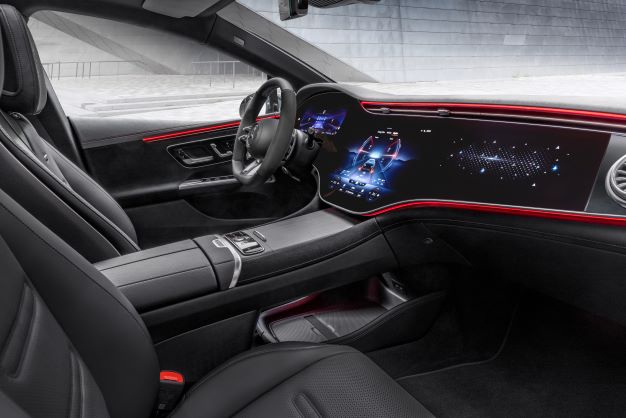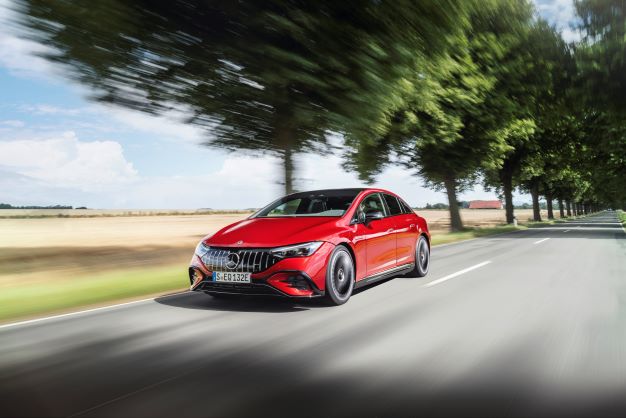JUST A few months after the South African launch of the EQS, Mercedes-Benz Cars South Africa is already presenting the next Mercedes-EQ model based on the electric architecture developed specifically for electric vehicles, the new EQE.
The sporty business saloon – the fifth model in the extensive Mercedes-EQ range offered locally – offers all the essential functions of the EQS in a slightly more compact format. At market launch, the local model range initially comprises two variants: the EQE 350+ with 215 kW and 565 Nm, as well as the Mercedes-AMG EQE 43 4MATIC with 350 kW and 858 Nm.
Production of the EQE offered in South Africa takes place at the Mercedes-Benz plant in Bremen, Germany.
“2023 is an extremely important year for the Mercedes-EQ offensive in South Africa,” says Mark Raine, Co-CEO of Mercedes-Benz South Africa and Executive Director of Passenger Cars. “Alongside the EQA, EQB, EQC and EQS, we’re introducing the all-new, avant-garde EQE. This business saloon cements our reputation as a manufacturer of class-leading, technologically advanced luxury vehicles in the EV space. With a driving range of up to 645 km, the EQE effortlessly reconciles innovation and emotion with forward-thinking sustainability.”
Compared to the luxury liner EQS, the EQE is even more streamlined, with a slightly shorter wheelbase, shorter overhangs and more recessed flanks – it carries the concept of the business saloon into the future.
Sensual Purity is reflected in generously modelled surfaces, reduced joints and seamless transitions (seamless design). The overhangs and the front end are kept short, the rear provides the dynamic accent with a sharp rear spoiler. Flush with the outer edge of the body, the 19- to 21-inch wheels, together with a pronounced muscular shoulder section, give the EQE an athletic character.
With the optionally available MBUX Hyperscreen, the entire instrument panel is a single, ultimate widescreen. This determines the aesthetics of the entire cockpit and interior. The high-resolution screens merge seemingly seamlessly under the shared glass cover.
The graphic appearance of their MBUX content is perfectly coordinated. The MBUX Hyperscreen is integrated into the instrument panel in minimalist fashion. The 12.3-inch OLED display for the front passenger gives them their own display and control area.
The vent band spans across the entire width at the top and is very slim at the same time. These extreme proportions, together with the glass wave of the MBUX Hyperscreen, create the avant-garde architecture of the cockpit. The outer nozzles feature a turbine design. They play on the theme hyperanalogue through the contrast between high-tech precision mechanics and digital, glass display world.
The latest MBUX generation, recently introduced in the EQS, is also on board the EQE. With adaptive software, the control and display concept completely adapts to its user and makes personalised suggestions for numerous infotainment, comfort and vehicle functions. With the zero-layer design, the user does not have to scroll through submenus or give voice commands. The most important applications are offered situationally and contextually on the top level in the field of view.
In this way the EQE driver is relieved of certain operating steps.
The EQE 350 with 215 kW plus the Mercedes-AMG EQS 43 4MATIC with 350 kW will be launched first.
The EQE 350 has an electric drivetrain (eATS) on the rear axle, while the AMG model is also equipped with an eATS at the front axle. The electric motors are permanently excited synchronous motors (PSM). With the PSM, the rotor of the AC motor is fitted with permanent magnets and therefore does not need to be supplied with power. The advantages of this design include high power density, high efficiency and high power constancy.
The motor on the rear axle is particularly powerful due to its six-phase design: it has two windings with three phases each.
In the EQE, the lithium-ion battery consists of ten modules and has a usable energy content of 90.56 kWh. The innovative battery management software, developed in-house, allows updates over the air (OTA). In this way, the energy management of the EQE remains up-to-date throughout the life cycle.
In the case of the battery, a major step has been achieved in terms of the sustainability of the cell chemistry: the optimised active material consists of nickel, cobalt and manganese in a ratio of 8:1:1. This reduces the cobalt content to less than ten percent. The continuous optimisation of recyclability is part of Mercedes-Benz’s holistic battery strategy.
Consistently high performance and multiple accelerations without a drop in power characterise the EQE’s drive philosophy. This includes a sophisticated thermal concept and several variants of energy recovery by means of recuperation. In this process, the high-voltage battery is charged by converting the mechanical rotary motion into electrical energy during overrun or braking mode. The driver can manually select the deceleration in three stages (D+ , D, D- ) as well as the gliding function via shift paddles behind the steering wheel. Also available: DAuto.
ECO Assist also offers situation-optimised recuperation – deceleration is so strong or weak that it ultimately results in the most efficient driving style. If possible, recuperative deceleration is also used for vehicles detected ahead. This even occurs until they come to a standstill, for example at traffic lights. The driver does not need to press the brake pedal for this – literally one-pedal driving.
Navigation with Electric Intelligence plans the fastest and most convenient route, including charging stops, based on numerous factors and reacts dynamically to traffic jams or a change in driving style, for example. This includes a visualisation in the MBUX infotainment system as to whether the available battery capacity is sufficient to return to the starting point without charging.
As a saloon with a boot lid, the EQE’s concept is well equipped to offer a high level of NVH comfort (Noise, Vibration, Harshness) into account.
Numerous measures contribute to this. In the electric drivetrains (eATS), the magnets are arranged inside the rotors in an NVH-optimised way (known as ‘sheet metal cut’).
In addition, the eATS have a special foam mat all around as an NVH cover. The inverter cover is a sandwich construction. The eATS are double-decoupled from the body via elastomeric bearings: highly effective spring/mass components provide continuous sound insulation from the crossmember under the windscreen to the floor of the boot. Acoustic foams are inserted into many carriers during body-in-white construction.
With the AMG SOUND EXPERIENCE, the performance and sports car brand is giving a new voice to electric mobility – a soundtrack for outside and inside that emotionally enhances the dynamic driving experience.
Like the drive programs, the acoustic composition has a wide bandwidth: in the standard basic version “Authentic”, the customer can regulate the sound and its intensity depending on the driving status and the selected drive program. The hallmark AMG driving sounds are generated with the help of additional hardware, including special speakers, a bass actuator and a sound generator.
Another option for even more individuality: using the AMG steering wheel buttons or the central display, the driver can select the sound characteristics “Balanced”, “Sport” and “Powerful” in any drive program. During RACE START, the vehicle produces a unique sound to match the dynamic acceleration.
The AMG DYNAMIC PLUS Package also includes the AMG SOUND EXPERIENCE “Performance”, which creates an even more emotional soundscape, also optionally “Balanced”, “Sport” or “Powerful”.

In addition to the drive sounds, it also includes most of the so-called event sounds – suitable sounds for all vehicle functions that emit a sound. This includes locking the vehicle, as well as starting and stopping the motor. The program even simulates the click of the indicators, because many drivers are unwilling to do without the familiar sound. A brand new feature is the AMG-specific event sound that is heard when the vehicle is locked. The event sounds can be deactivated at any time via the multimedia system settings – separately for the exterior and interior.
The suspension of the new EQE, with four-link front suspension and multilink rear suspension, is closely related in design to the current-generation S-Class. As an option, the EQE is available with AIRMATIC air suspension with ADS+ adaptive damping system. With rear-axle steering (optional extra), the EQE feels as manoeuvrable as a compact car in the city. The steering angle at the rear axle is up to ten degrees. The turning circle is reduced from 12.5 to 10.7 metres with rear-axle steering.
On the EQE 43 4MATIC, (optional) AMG RIDE CONTROL+ air suspension with adaptive adjustable damping has been optimised with AMG-specific wheel carriers, suspension links and anti-roll bars with higher rigidity. The AMG engineers have specifically tuned all components to meet the special requirements of AMG customers. This applies to ride comfort as well as driving dynamics.
New vehicle functions can be activated via over-the-air technology (OTA). Available from launch: the additional sound experience “Roaring Pulse”, two special driving modes for young drivers and service personnel, as well as small games.
The principles of Integral Safety, in particular accident safety, apply regardless of the platform. Like all other Mercedes-Benz models, the EQE therefore has a rigid passenger cell, special deformation zones and modern restraint systems with PRE-SAFE®.
The fact that the EQE is based on an all-electric architecture also opened up new design possibilities for its safety concept. It meant, for example, that a favourable location could be chosen for the installation of the battery, in a crash-protected area in the underbody. And because there is no large crankcase on board, the behaviour in a frontal crash could be modelled even better. In addition to the standard crash tests, the car’s performance in various additional load situations was verified and extensive component tests carried out at the Vehicle Safety Technology Centre (TFS).
The latest generation of driving assistance systems includes numerous driver support functions.
One new function is the additional microsleep warning from ATTENTION ASSIST (in conjunction with MBUX Hyperscreen). It analyses the driver’s eyelid movements using a camera in the driver display. The assistance display within the driver’s display shows the operation of the driving assistance systems in a comprehensible full-screen view.
The EQE 350+ will be available in South Africa at an estimated price of R1,800,000 and the Mercedes-AMG EQE 43 4MATIC at an estimated price of R2,200,000.
This includes a PremiumDrive Platinum 5-year/100,000 km maintenance plan and a 10-year battery warranty.

